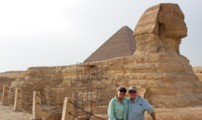Chennai was formerly known as Madras and is the cultural center of Southern India. In our youth, our parents told us to finish all the food on our plates because the children in India didn’t have any. This is true for part of the large 21M population of Chennai. During lectures on our ship prior to arrival, we learned about the vast contrasts of India such as religions, preference for spices, skin color, attitude towards females, family customs, dress, employment, per capita income, health care, education, and all those numbers that made sense in the sterile environment of our mothership. Chennai has a 140 year draught problem. The Viking Sun’s passengers were not prepared for any of the daily sightseeing excursions, it was just plain emotionally shocking on so many levels. Just getting through immigration could be politely described as schizophrenic and bureaucratic. Five people fell on uneven surfaces as they were viewing the countryside just off the gangplank, one now sports a cast. The onrush of taxi drivers, tuk-tuk owners, and souvenir vendors was crushing.
We signed up for the Mylapore Heritage Walk and a ride on the Parakum Rail. All the lecturers tried to warn the guests of what to expect in India. The weather was in the 90’s with thunderstorms expected, i.e. weatherman code for extremely humid. The streets are filled with debris, potholes, cracked cement and cow pooh. You can’t look up for fear of tripping over something. Cows are sacred and allowed to roam the streets. The locals feed them, pet them and just step over the pooh. You must also be careful not to get in the way of Tuk-Tuk drivers; they will run you over or put their arms out and push you out of their way. This was truly an eye opener.
Our bus ride passes the second longest beach in the world with the longest being in Florida. It’s actually pretty with white sand and lots of beach umbrellas. Its Sunday, so many people are out enjoying the day. We see a number of play areas filled with boys playing soccer, cricket and volleyball. The Friday before was some sort of festival which was attended by some 50,000 people so there was more trash than usual (ha) and all the ATM machines were empty. Our bus arrived at the start of the walking excursion, and stepping off to walk the streets took our breath away; primarily poverty and filth. We saw what was left of the float used in the festival which was human powered. There were a number of nice looking high rise buildings, all built by the British. There were many beggars on the street, some standing, some sitting; all hoping someone will put a coin into their hands. There were also a lot of vendors trying to capture tourist money. Most of the women are in saris, men in loin cloths and everyone wears sandals or no shoes at all. No hats are worn and their skin is like leather from the constant sun.
My personal opinion is that residents don’t have the energy to move let alone build anything or clean anything because of draining the heat and humidity.
We walked to a well air-conditioned restaurant for lunch which was much appreciated and very good. We were served on individual silver platters that had about 8 deep depressions, each filled with an Indian delicacy. We had bottled water and they also had western toilets…oh boy!
Next we walk to the train station. We are a group of 28 but our guide splits us into 2 groups which we find odd. Then we figure it out. The train only stops for 60 seconds and there’s no way he’s going to get 28 old people on that train in 60 seconds so by splitting us up and giving his assistant 14, he stands a better chance. He keeps hollering out, get closer, ready, tighten up the group, ready; it’s a laugh out loud moment. We actually get on and get off without losing anyone. We had first class tickets which means we get to sit in a car with cracked, ripped and dirty padded seats 60 cents. The coach passengers only get wooden seats because they only pay 7 cents. If you’ve ever seen a movie filmed in India where the people are on a train, that’s exactly how it looks. No glass on the windows, bars down the center so you can’t jump out but you could jump out the door because there is no door. They also have the leather straps hanging from the ceiling that you can hold on to if you’re inclined to touch the leather straps. The view from the window is overwhelming. It’s poverty at its worst; the filth, the broken down shacks, small children with no clothes on, adults without shoes. One beggar lying on the sidewalk had swollen feet that were solidly covered with flies; no picture could be taken because of my shock. In days, this man will have his feet amputated or die. You’ll see a temple laden with gold with the people walking into it and praying. India has 1,300,000,000 or 1.3 billion people.
Twenty minutes later, we hop off the train and board our bus to return to the safety and cleanliness of our ship. Everyone cleans their shoes, showers, and sanitizes. At dinner, we compare notes from each of the five tours of the day. We have three more stops in India for a more averaged opinion. This short piece has been edited several times.
Our local tour guide was just like the young owner in the second Marigold Hotel movie; he could change the topic and with blinding speed point out something positive and great. He noticed me photographing the dilapidated train station and stated with vigor that it was mango season. Indian mangos are the best and have great flavor and sweetness, we must try them. We are truly on an adventure.




















